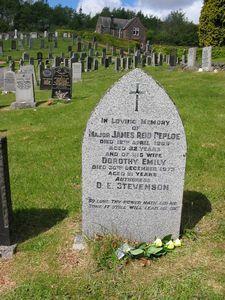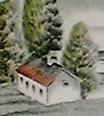D. E. StevensonA Little Biography
|
A Few Words about D. E. Stevensonby Kristi JalicsDorothy Emily Stevenson was born in November of 1892 in Edinburgh, Scotland, into a family well-known both as the engineers who had established lighthouses around the dangerous northern coasts of the United Kingdom, and as writers of note. Her father's cousin Robert Louis Stevenson was already famous for his novels and travel writing, but there were many unpublished diarists as well.DES was strongly attracted to writing, even as a child, despite her parents' disapproval. She loved to read and write and was not above hiding out in an attic room where she could pursue these passions undisturbed. But she loved other pursuits as well, and was such a successful golfer that she was considered for inclusion on the Scottish Ladies Team. In 1913 Dorothy enjoyed a season as a debutant in Edinburgh, and in 1915 her first book of poetry was published, but the outbreak of war in 1914 changed the focus of her life. In 1916 she married a young officer, James Reid Peploe, a family friend who was home recovering from the wounds of war. Within a year their first child was born and a good deal of her attention must have turned to her life as an officer's wife and mother of a lively young family. Stevenson was the mother of four children, two daughters and two sons, the youngest being born in 1930. In 1928 her oldest daughter died tragically from a mastoid infection while at school But while busy with life, DES found time to write. Another book of poetry came out, and in 1923 her first novel, Peter West, was published. It was not a great success and no more novels were published for a number of years, though she continued to keep a diary, and was always most interested in the characters and personalities of the people she met. In the early thirties a friend, Mrs. Rupert Ford, whose daughter was about to marry an army officer, borrowed Stevenson's diary to get a sense of what her daughter's life was going to be like. She enjoyed it greatly and urged DES to publish it. With some changes this was done and, to Stevenson's surprise, Mrs. Tim proved to be quite popular. From that time on until the end of her life in the early 1970s, Stevenson steadily wrote the books which still delight her readers. She wrote humorous books and serious ones, and even ventured into science fiction. During WWII she wrote books with spies in them as well as those about the home front. In the fifties and sixties her works were often seen as romances, but they were always much more than that. Her fascination with people and the way their personalities affect their lives never left her. After the bombing of Glasgow in the early 1940s, she and her husband James moved to Moffat, Scotland and became part of the community there. Stevenson was involved with her church, sang in the choir and worked with the Girl Guides. James was on the local council. They seem to have lived a life not that unlike the ones she wrote about in her many novels. More than once, she expressed the hope that her books would be like lighthouses for her readers, and more than thirty years after her death a host of readers still believe this is the case.
|
|
|

